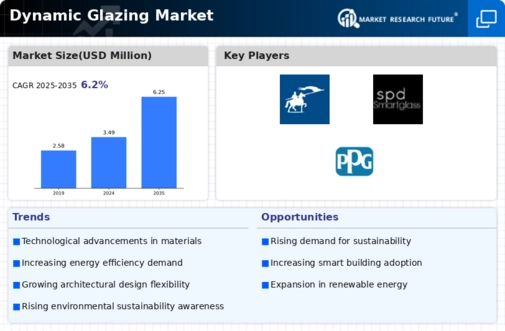Market Analysis
In-depth Analysis of Dynamic Glazing Market Industry Landscape
The dynamic glazing market operates within a dynamic framework influenced by various factors that shape supply, demand, and pricing dynamics. Dynamic glazing, also known as smart or switchable glass, is a technologically advanced glass product that can change its properties in response to external stimuli such as light, heat, or electricity. One of the primary drivers of market dynamics is the increasing demand for energy-efficient and sustainable building solutions. Dynamic glazing offers benefits such as solar heat control, glare reduction, and daylight harvesting, making it a popular choice for green building projects and energy-efficient building designs. Factors such as energy regulations, environmental concerns, and the need for improved indoor comfort drive demand for dynamic glazing in the construction industry.
The products used in construction activities that can change the properties of performance automatically is known as dynamic glazing product. The windows and doors, which are dynamically glazed, change their performance automatically to respond to environmental signals or control. Dynamic glazing is used to darken the interior piece of glass electrochromic technology.
Supply dynamics in the dynamic glazing market are influenced by factors such as manufacturing capabilities, technological advancements, and raw material availability. Dynamic glazing products are manufactured using specialized glass coatings, lamination techniques, and electrochromic or photochromic materials that enable them to change their properties in response to external stimuli. Manufacturing capabilities, including production capacity, process efficiency, and quality control measures, play a crucial role in shaping supply dynamics by determining the ability of manufacturers to meet market demand. Moreover, advancements in glass coating technologies, smart materials, and manufacturing processes contribute to product innovation and expanding the range of available dynamic glazing solutions.
Market dynamics are further influenced by factors such as regulatory standards, building design trends, and technological innovations. Regulatory standards related to energy efficiency, building codes, and environmental sustainability influence market dynamics by setting requirements for building materials and construction practices. Building design trends, such as the increasing adoption of green building principles, daylighting strategies, and passive solar design, drive demand for dynamic glazing solutions that can enhance energy performance and occupant comfort. Additionally, technological innovations in smart glass technologies, such as electrochromic, photochromic, or thermochromic glazing systems, contribute to product advancements and market growth.
Pricing dynamics in the dynamic glazing market are influenced by a combination of factors including manufacturing costs, technological advancements, competitive pressures, and market demand-supply dynamics. Manufacturing costs for dynamic glazing products, including materials, processing, and assembly expenses, directly impact pricing decisions for manufacturers. Technological advancements in smart glass technologies and manufacturing processes contribute to cost reduction and efficiency improvements, influencing pricing strategies adopted by market players. Competitive pressures within the industry, driven by factors such as market concentration, brand reputation, and product differentiation, also influence pricing dynamics. Moreover, demand-supply imbalances, fluctuations in raw material prices, and changes in construction activity levels can exert short-term pressures on prices.
Environmental considerations and sustainability trends are increasingly shaping market dynamics in the dynamic glazing industry. With growing awareness of environmental issues and sustainability goals, stakeholders across the value chain are prioritizing the use of energy-efficient and environmentally friendly building materials. Dynamic glazing products contribute to energy savings, indoor comfort improvements, and daylight utilization, aligning with sustainability objectives in the construction industry. Additionally, certification programs promoting green building materials and government incentives for energy-efficient building solutions further influence market dynamics by shaping consumer preferences and industry standards.






Leave a Comment